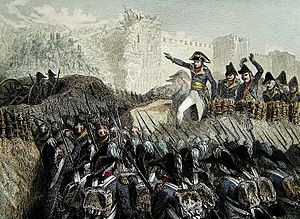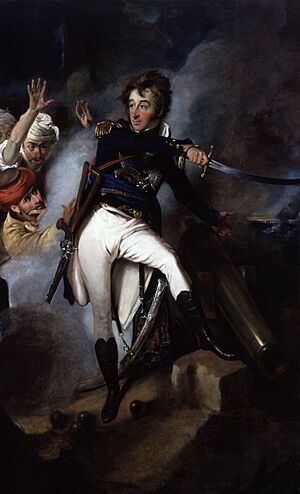Siege of Acre (1799) facts for kids
Quick facts for kids Siege of Acre |
|||||||
|---|---|---|---|---|---|---|---|
| Part of the French Campaign in Egypt and Syria during the War of the Second Coalition | |||||||
 Failed siege of Acre by French forces led by Napoleon |
|||||||
|
|||||||
| Belligerents | |||||||
| Commanders and leaders | |||||||
| Units involved | |||||||
(Garrison Force) |
|||||||
| Strength | |||||||
| Garrison: 5,000 men Relief army : 40,000 Support: 2 British ships of the line |
12,000-13,000 | ||||||
| Casualties and losses | |||||||
| 2,000 (for the siege) |
4,000
|
||||||
The Siege of Acre in 1799 was a major battle. It happened when French forces, led by Napoleon Bonaparte, tried to capture the city of Acre. Acre was part of the Ottoman Empire at that time.
This siege was a key moment in Napoleon's invasion of Egypt and Syria. It was one of the few times Napoleon faced a defeat in his military career. After failing to take Acre, Napoleon and his army had to retreat to Egypt.
Contents
Why Acre Was Important
Acre was a very important city because of its location. It was on the main route between Egypt and Syria. Napoleon wanted to capture it after he invaded Egypt. He hoped that taking Acre would encourage people in Syria to rebel against the Ottomans. He also wanted to threaten British interests in India.
The Siege Begins
The French army started attacking Acre on March 20, 1799. Napoleon thought his soldiers could quickly take the city. He believed it would only take two weeks to capture this important city in the Holy Land before moving on to Jerusalem.
Strong Defense of Acre
However, the city's defenders were very determined. They were led by Jezzar Pasha. His Jewish adviser, Haim Farhi, also played a big part in defending Acre. He directly oversaw the fight against the French.
The people of Acre knew what had happened in Jaffa. Before attacking Acre, Napoleon's troops had captured Jaffa. Many prisoners of war there were killed. This made the defenders of Acre even more determined not to surrender.
British Help Arrives
The British Royal Navy helped the Ottoman defenders. A group of British ships, led by Commodore Sidney Smith, arrived. His ship, the Tigre, helped a lot.
The British ships brought more cannons and supplies to Acre. Sailors and marines helped to operate these cannons. Smith also used his ships to capture French siege artillery that was being sent by sea from Egypt. He also bombed the coastal road from Jaffa.
An expert in artillery, Antoine Le Picard de Phélippeaux, who was with the British fleet, then used the captured French cannons against Napoleon's army.
Commodore Smith positioned his ships, Tigre and Theseus, so their powerful side cannons could help defend Acre. Smaller British gunboats could get even closer to the shore. Together, they helped push back many French attacks.
On April 16, an Ottoman relief army was stopped at Mount Tabor. By early May, new French siege cannons arrived by land. These cannons helped the French create a hole in Acre's walls.
A Second Wall
After breaking through the first wall, Napoleon's soldiers tried to enter the city. But they found that Farhi and de Phélippeaux had built a second wall inside the city. This new wall was several feet behind the first one, in what was Jazzar Pasha's garden.
Finding this second wall made Napoleon realize that taking the city would be very difficult. Also, after another French attack was pushed back, more Ottoman soldiers arrived from Rhodes by sea.
Challenges for the French
Napoleon's army faced many problems. They had underestimated how determined the defenders were. The British navy also blocked French supply ships. The weather was bad, leaving the French soldiers hungry, cold, and wet.
A serious illness, the plague, also spread through the French camp. This was due to the difficult conditions. About 2,000 French soldiers died from the plague.
Napoleon's Retreat
Napoleon had tried to get help from Bashir Shihab II, the ruler of much of present-day Lebanon. But Bashir remained neutral. This hurt the French more, as Bashir's help might have changed the outcome.
Finally, Napoleon gave up the siege. After a final failed attack on May 10, Napoleon and his army retreated on May 21. They went back to Egypt.
Why the Siege Was Important
The failure to capture Acre was a big setback for Napoleon. It stopped his plans to expand his control further into the Middle East. If he had taken Acre, the history of France and Europe might have been very different.
Napoleon was very interested in gaining the support of Jewish people during his campaign. Some stories say he promised to return the land to the Jews if he conquered Palestine. This might have been to get help from Haim Farhi, who was Jewish. However, Farhi remained loyal and helped defend Acre.
Acre's Legacy Today
Today, the hill where Napoleon set up his camp, southeast of Acre's walls, is still called "Napoleon's Hill" (גבעת נפוליון). Acre is the only city in Israel with a street named "Napoleon Bonaparte Street" (רחוב נפוליון בונפרטה).
The people of Acre are proud that their ancestors successfully defended their city against such a famous conqueror. There's a local story that when Napoleon left Acre, he shot his hat into the city with a cannon. He supposedly said this was "so that at least a part of him would enter into Acre."
Images for kids
-
19th-century cannon, set in the wall of Acre near a sign commemorating Farhi. The Hebrew inscription on the sign reads: "Farhi vs. Napoleon. Jezzar's right hand in resisting Napoleon's harsh siege was the Jewish Haim Farhi, senior adviser and minister of finance"







